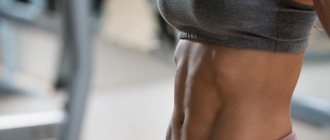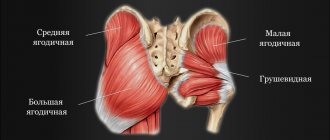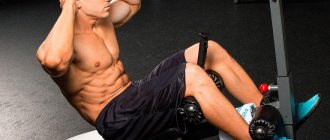If you and I are anything like you, you probably feel like you're not fully working your lower abs. It seems that no matter how hard you work, nothing changes. Well, there are reasons for that.
“To lose weight and get ripped muscles, you need to train your entire body,” says Amanda Butler, a certified trainer and instructor in New York City.
“You need to burn calories and combine this process with a balanced diet.” You may have heard the expression, “The best abs are made in the kitchen”?
But this is not a reason to skip lower abdominal exercises for girls - crunches and planks. "It's important to train your core muscles because they are your center of balance," says Butler.
“Plus, strong abdominal muscles can help reduce back pain.”
Don't know how to pump up your lower abs at home? You are not alone. “The lower abs are very difficult to strengthen because they are the area where your body stores all the excess fat.” “And in women, the hormone estrogen “wants” to accumulate as fat in this area.”
Lying leg raise
One of the simplest, but very effective exercises, is performed lying on the floor without any equipment. An important requirement in the execution technique is a stable position of the lumbar spine. To help the abdominal muscles, which are not sufficiently prepared to press the lower back to the floor, you can place your palms under your buttocks. To reduce the load, you can work on one leg at a time.
Read more about leg raises →
Pulling your knees to your chest with a lying ball
This exercise can be performed without equipment, especially for beginners. But a more effective option is to pull your knees to your chest using a fitball held between your ankles. During the entire exercise, the fitball should not touch the floor. Hands can lie on the floor along the torso or under the buttocks, helping the abdominal muscles fix the lower back. When straightening your legs, the angle of your legs relative to the floor can be 45 degrees or higher. As you exhale, you need to pull your knees to your chest without losing the ball. You can also use any ball at your disposal.
Pulling your knees to your chest on a fitball
This is a rather difficult exercise because it requires good stabilization of the body and preparation of the deep muscles of the body. In this embodiment, all the main muscle groups work statically, but the dynamic work is performed by the rectus abdominis and transverse abdominal muscles, especially their lower part. When performing knee-to-chest pull-ups, it is important to maintain balance and not fall to the sides. In the starting position, the knees should be on the ball, this will provide a sufficient range of motion when pulling the knees.
Leg raises with fitball
This version of leg lifting is performed in the same way as in the first exercise, but the amplitude is already significantly reduced due to the volume of the ball, which should not touch the floor. During the entire approach, the abdominal muscles should be tense, fixing the lower back. At the bottom point of the movement, the legs form approximately 45 degrees, and at the top they become 90 degrees. You can also use a simple soccer or medicine ball instead of a fitball.
How to do Kegel exercises
These exercises are very easy and quick to do. Maybe you're already training hard without even noticing it.
- Feel the muscles you use to stop urinating;
- Squeeze them for a count of three;
- Never tense your stomach or thighs when doing this movement;
- Increase the time by 1 second each week until you reach 10 seconds;
- Try repeating this exercise 10 to 15 times per set;
- Try to do three times a day;
- Never do Kegel exercises while you are peeing because it can damage your bladder.
If you suffer from back pain and incontinence, you may have weak core muscles. Without strengthening training, pelvic organ prolapse is a real risk. Prolapse occurs when, for example, the bladder moves down the abdomen.
And ideally, the bladder is pressed against the walls of your vagina. Organs that may be involved in pelvic prolapse are the bladder, uterus, urethra, small intestine, vagina and rectum.
Your muscles need to contract and relax quickly to improve pelvic floor functionality. The way you walk, stand, sit or turn also affects whether you use your pelvis correctly.
The good news is that such problems are not hopeless. Eat right, exercise, and improvements will follow.
Reverse crunches
This is one of the most effective isolation exercises for the lower abdomen. It is performed both while lying on an inclined bench and on the floor. Its distinctive feature is its short amplitude with a strong impact on the lower part of the rectus abdominis muscle. When pushing the pelvis up, it is important to perform a short movement exclusively with the abdominal muscles. Upward thrusts of the pelvis should not be accompanied by high lifting of the pelvis and lifting of the lower back, jerking and falling to the floor.
Learn more about the reverse crunch exercise →
Lower abs in girls
In fact, it is in some ways easier for a girl to pump up her lower abs than for representatives of the stronger sex. Thanks to the excellent stretching that women have, it is much easier for them to perform many physical exercises to correct their figure. The only thing in which men are ahead is in relief. Unfortunately, the female body is designed in such a way that it is quite difficult to get such attractive “cubes” on the stomach without taking hormonal drugs. This will require years of regular and prolonged training, preferably under the guidance of an experienced trainer.
Leg raises on parallel bars
Leg lifts can be performed indoors or outdoors - on specialized sports grounds or school yards. The only difference between parallel bars in the gym and street bars is the presence of cushions for resting on the forearms, which provide maximum comfort when performing the exercise. Street equipment has only two parallel bars, which involve performing the exercise while standing on straight arms. This option is suitable for physically fit women. An important condition is a stable position of the torso and prevention of swaying of the whole body.
Leg raises on the horizontal bar
Leg raises are often used in CrossFit or street workout. This technique is suitable for trained athletes, if we talk about the technique with the feet touching the crossbar. In other cases, you can raise your straight legs until they are parallel to the floor or bend your knees. This will reduce the load on your abdominal muscles. But the difficulty here will lie in something else - weak ligaments and arm muscles will not be able to hold the body hanging for a long time, so you should prepare the upper shoulder girdle so that the arms do not get tired until the abdominal muscles become tired.
Read more about hanging leg raises →
Cardio load
Cardio training is aimed at burning fat and developing the heart muscle. You can choose any direction: running, swimming, jumping, fast walking, as well as training on special simulators. It doesn't matter which of these directions you choose. The main thing is the right approach and regularity in training.
- Know the lower and upper range of your heart rate. And maintain it in these ranges
- Do cardio only at the end of your workout or on non-training days so as not to interfere with your muscle growth progress.
- The duration of the workout should be 30-40 minutes 3-5 times a week
- Only strength training combined with cardio effectively burns fat.
And remember a lot of cardio does not mean good. Everything should be in moderation. You are not a machine, so you approach everything wisely.
fold
This exercise is performed using a technique reminiscent of a “book”. Here the rectus abdominis muscle is fully engaged, but the lower part of the abs is worked out no less intensively in the fold due to the dynamic movement of the legs. The exercise can be performed both on a bench, holding the edges of the bench, and on the floor, resting your palms on the floor. The pace should be quite vigorous, but concentration on the abdominal muscles is important, since helping with your hands and feet can significantly reduce the load on the rectus abdominis muscle.
Plank running
The dynamic version of the plank allows you to strengthen not only the external abdominal muscles, but also the internal ones, including the transverse muscle. The lower abs receive significant load here by throwing the knees towards the chest, simulating running with high knees. For those who find it difficult to perform the exercise at a fast pace, you can replace the option by pulling up one knee at a time at a slow pace, this will allow you to concentrate on working your abdominal muscles without disrupting your breathing rhythm.
Interval Cardio Training
Without proper cardio exercise, it is impossible to reduce your fat percentage below 12-10%. No matter how much you eat right and no matter how much you train correctly on machines or with free weights, super series, pumping up your abs, you will not be able to dry out.
Types of cardio exercises
There are many options. They are all different and have different effects on the body of a particular person. This could be running with acceleration or, for example, an exercise bike or rowing machine.
Until you have learned to feel your body absolutely, and this will come when you have worked out for some time with a heart monitor, you need to monitor your heart rate.
When you can maintain such a pulse for 20-40 minutes 3-4 times a week during cardio exercise, then you can already use interval cardio training. They are effective for burning subcutaneous fat.
Example of interval training on an exercise bike
Start your workout and gradually work your way up to 70% of your maximum heart rate. Hold this level for several minutes. This, in turn, will create the effect of entering the upcoming workout. Many will say that pedaling a stationary bicycle is boring - this is true, so choose an invigorating track list for your player.
- Warm-up lasts 7-8 minutes.
- After which there is a first interval of about 2-3 minutes. Imagine that there is a mountain in front of you that you need to cross. The pulse at this interval should be 85% of the maximum.
- After which we pedal for 7-8 minutes at the same pace as during warm-up.
- The second interval lasts longer - 4-5 minutes, and your heart rate should reach 90% of maximum in the last minute.
- Then again 7-8 minutes as in the warm-up.
- The workout should last 30-40 minutes 6 times a week.
Remember that when you train on machines or with free weights, you can do something without water. No literate person trains without water.
The fluid that flows out of us is filled with salts, electrolytes and minerals without which our body is not able to function normally.
Plank jumps
The next variation of the plank is jumping back and forth. The technique also involves dynamic jumping. By jumping with your feet forward, your lower abs work intensively. This is also an effective fat-burning exercise, but it is not recommended for those who have pain in the knees and spine.
Pelvic muscle health
We will begin to analyze exercises for the lower abs with movements aimed at strengthening the pelvic floor, which is especially important for girls. You should not have problems with the pelvic muscles, which can arise either because you have a sedentary job and do not have time to train, or after the birth of children. Here are some of the common complaints that mommies suffer from:
- Backache;
- Poor posture;
- Incontinence;
- Tension in the neck and shoulders;
- “Bloated” tummy;
- Drawing sensations in the pelvic area;
- Haemorrhoids;
- Constipation.
Dysfunction of the pelvic diaphragm muscles occurs due to a combination of many factors: obesity; trauma occurring during hysterectomy or other surgical intervention; natural childbirth; aging; lifting heavy objects, etc.
Pregnancy or natural childbirth can stretch or weaken some of the supporting muscles in your pelvis. The more children a woman has, the weaker her muscles become.
Knee pull-up in TRX
For training in the gym, as well as at home if you have loops, you need to use one of the main options for developing strong abs, especially the lower abdomen, namely pulling up the knees in TRX. This technique is similar to the fitball exercise described above, but the advantage of loops is that there is no risk of falling and injury as with a ball. The important point here is to avoid sagging in the lumbar region.
And also read: Exercises for the upper abs → How to pump up the side abs → Exercises on a fitball for the abs →
Home Workout Basics
In order to pump up abs, remove excess fat and tone your body, you don’t have to go to the gym. You can achieve good shape by doing gymnastics at home without special equipment.
All you need is a gymnastics mat or an alternative. You can also perform exercises with additional weights: dumbbells, plates, balls or weights. Having a fitball will allow you to diversify your exercises and use additional muscle groups.
You can train muscles, including the abs, on sports grounds using parallel bars and horizontal bars.
Rules
The first thing you need to decide on before starting training is the purpose of the training. If you want to tone your muscles and remove excess fat, then high-repetition exercises without additional weight will be most effective. If the goal is to pump up your abs and make your abs expressive, then you should use weights and additional weights in your workouts. At the end of classes, it is recommended to add cardio loads to achieve more noticeable results.
In order for the classes to be beneficial, you need to follow a few simple rules:
- Warm up before every workout . Before starting exercises, you should warm up your muscles and ligaments well and prepare your body for the load. Warm-up can be joint or aerobic.
- Follow the technique of doing the exercises . This condition allows you to avoid injuries, correctly distribute the load, and deeply work the target muscles.
- Gradually increase the load . You should start with minimal loads, gradually increasing them so that the muscles do not have time to adapt to the load. You can increase the pace, the number of repetitions, or the weight of additional equipment.
- Exercise regularly . The most effective is considered to be three workouts per week. You can exercise more often, but provided that the muscles have had time to rest and recover.
An additional rule for pumping up the abs is a combination of dynamic and isometric exercises in training.
Isometric exercises are exercises in which the joint angle and muscle length do not change compared to concentric (dynamic) movements. Isometrics involves a person being in static positions.
It is recommended to change the training program once every 1-2 months, replacing exercises or the order of their implementation during the training week. Changing exercises more frequently is also undesirable.
Contraindications
Abdominal training has some limitations:
- pathologies of the cardiovascular system (arrhythmia, angina, heart failure);
- serious diseases of the musculoskeletal system (vertebral displacement, pinching);
- diseases of the respiratory system (bronchial asthma);
- pregnancy.
You should not exercise if you have inflammation, exacerbation of chronic diseases and painful menstruation. Before starting training, you should consult your doctor.











